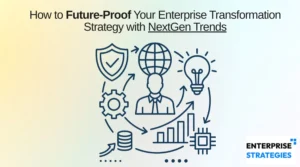Digital transformation fails 70% of the time. This isn’t just a statistic—it’s what we’ve seen working with companies trying to modernize their operations. The difference between success and failure? A solid enterprise architecture foundation.
When CEOs ask me why their expensive technology initiatives aren’t delivering results, the answer often comes down to missing this critical piece. Enterprise architecture isn’t just diagrams and documentation—it’s the backbone that ensures your transformation efforts actually solve business problems instead of creating new ones.
What Enterprise Architecture Really Means in 2025
Enterprise architecture (EA) has evolved far beyond IT diagrams and technical roadmaps. Today, it’s about creating a business-focused blueprint that connects your strategy directly to execution.
Think of EA as your company’s GPS system through digital transformation—it shows where you are, where you need to go, and the most efficient route to get there while avoiding expensive detours.
The core components that matter most:
→ Business capability mapping
→ Technology portfolio management
→ Integration frameworks
→ Data governance models
In practice, EA means knowing exactly which systems talk to each other, where your critical data lives, and how information flows through your organization. Without this visibility, transformation initiatives quickly go off track.
The Hidden Costs of Skipping Architecture Work
Many companies jump straight into implementing new technology without mapping their enterprise architecture first. The results are predictable:
- Duplicate systems performing the same functions ($800K average annual waste)
- Integration nightmares between new and legacy systems
- Data quality issues that undermine analytics and reporting
- Security vulnerabilities from unknown system connections
We see this pattern repeatedly in our Enterprise Evolution and Change Management practice. What should be a 12-month implementation turns into a 2-year ordeal that delivers half the expected functionality.
How to Know If Your Architecture Is Holding Back Transformation
Before investing millions in new technology, assess where your enterprise architecture stands today:
- Can your leadership team explain how information flows between departments?
- Do you have a single source of truth for customer data?
- Can you quickly identify all systems impacted by a proposed change?
- Is there clear ownership of data across your organization?
- Can you trace the impact of system outages on business processes?
If you answered “no” to two or more questions, your architecture needs attention before proceeding with major digital initiatives.
“Companies spend an average of 40% of their transformation budgets fixing problems that proper architecture work would have prevented.”
The 90-Day Framework for Fixing Enterprise Architecture
When we work with clients who need to strengthen their architecture foundation quickly, we use this practical approach:
| Week | Focus Area | Deliverable |
| 1-2 | Current State Assessment | System inventory and connection map |
| 3-4 | Business Capability Mapping | Core capabilities vs. supporting technologies |
| 5-8 | Gap Analysis | Prioritized list of architecture weaknesses |
| 9-12 | Target Architecture Design | Transformation roadmap with clear dependencies |
The key difference in our approach: We focus on actionable insights rather than perfect documentation. Most architecture efforts get bogged down in creating exhaustive diagrams that no one uses. Instead, we identify the minimum viable architecture needed to support your transformation goals.
Real-World ROI from Getting Architecture Right
Companies with mature enterprise architecture practices see tangible benefits:
- 27% faster digital transformation delivery timelines
- 32% reduction in technology maintenance costs
- 41% improvement in project success rates
These aren’t just numbers—they translate directly to competitive advantage. Through our Advisory Services, we’ve helped clients identify simple architecture gaps that were preventing major business improvements.
Where Most Enterprise Architecture Programs Go Wrong
Despite the clear benefits, many architecture initiatives fail to deliver value. The most common pitfalls:
- Treating architecture as a documentation exercise rather than a decision-making tool
- Isolating architecture in IT instead of connecting it to business strategy
- Focusing on technical perfection rather than practical business outcomes
- Creating overly complex models that teams can’t understand or use
- Missing regular refresh cycles as the business evolves
The best enterprise architects I’ve worked with spend 70% of their time with business stakeholders and only 30% on technical documentation. 💡
The Architecture Decision Record: A Simple Tool with Massive Impact
One practical tool we’ve seen transform architecture’s effectiveness is the Architecture Decision Record (ADR). This single-page document captures:
- The business context for a technology decision
- Options considered (with pros/cons)
- The selected approach
- Implementation considerations
Here’s why it works: ADRs create alignment between business and IT teams without requiring extensive technical knowledge. They force clarity around why decisions are made, not just what was decided.
How to Build a Business-Focused Architecture Practice
If you’re serious about using enterprise architecture to accelerate transformation, start here:
1. Connect architecture to business outcomes
Instead of: “We need to document all our systems and interfaces.” Ask: “Which architecture elements directly impact our top 3 strategic initiatives?”
2. Start with data architecture
Your organization’s ability to make decisions is only as good as your data. Map where critical business data lives, how it moves, and who owns it before tackling application architecture.
3. Measure architecture value in business terms
Track metrics like:
- Reduction in project delays due to architecture issues
- Technology cost savings from consolidation
- Improvement in data quality for key business decisions
4. Make architecture decisions visible
Create a simple architecture review board with business and IT representation. Meet biweekly to ensure major technology decisions align with your target architecture.
5. Build architecture capabilities incrementally
Don’t try to mature all aspects of enterprise architecture simultaneously. Focus first on the domains with the highest business impact—typically data and integration architecture.
What CEOs Need to Ask About Enterprise Architecture
As a business leader, you don’t need to understand the technical details of architecture, but you should ask these five questions:
- “How does our current architecture support or hinder our strategic goals?”
- “What are the three biggest architecture risks to our digital transformation?”
- “How do we ensure new technology investments align with our target architecture?”
- “What redundancies exist in our current technology landscape?”
- “How mature is our data architecture compared to industry standards?”
If your team can’t answer these questions clearly, you have an architecture gap that’s likely costing you money and slowing your transformation.
The Workforce Dimension: Architecture’s Role in AI Adoption
Enterprise architecture isn’t just about systems—it’s increasingly about how your workforce integrates with technology. As organizations implement Workforce AI and Automation solutions, your architecture must account for:
- Which processes can be safely automated
- How human workers will interact with AI systems
- Where decision authority resides (human vs. machine)
- How to measure and improve human+machine performance
Without this architectural clarity, AI implementations often create more problems than they solve, with workers developing workarounds that undermine the intended benefits.
Our Approach: Architecture That Delivers Real Results
At Enterprise Strategies, we’ve helped companies build practical architecture foundations that accelerate transformation rather than slow it down.
Our approach differs in three key ways:
- We work from business capabilities down, not technology up
- We focus on decision support, not documentation
- We build architecture governance into existing processes rather than creating new bureaucracy
When working with clients on digital transformation, we’ve found that fixing fundamental architecture issues often delivers immediate value before making any major technology investments.
Next Steps: Assess Your Architecture Readiness
Want to see how your enterprise architecture compares to others in your industry? Email us at info@enterprisestrategies.com with the subject line “Architecture Assessment” and we’ll send you our 10-minute diagnostic tool. You’ll get immediate insights on where your architecture stands and which areas need attention before you invest in new systems.
You can also contact us directly to discuss how we can help strengthen your enterprise architecture foundation.




